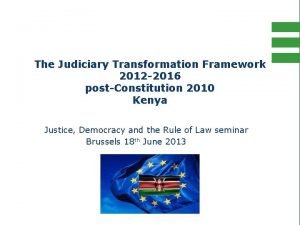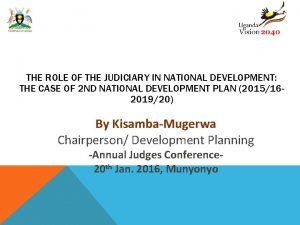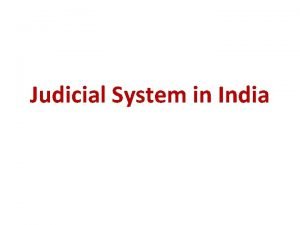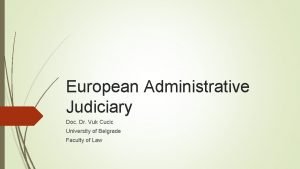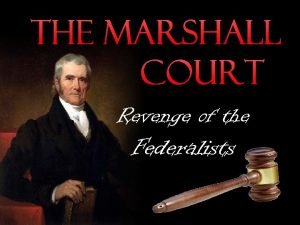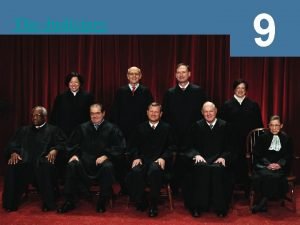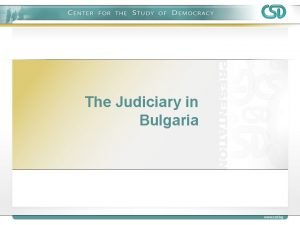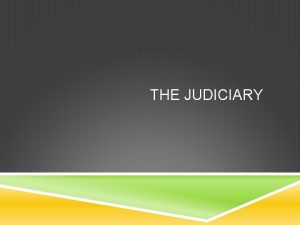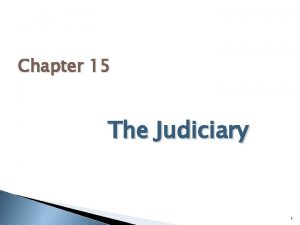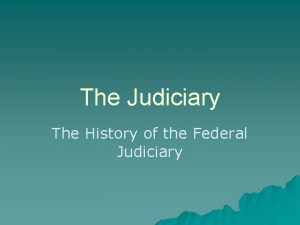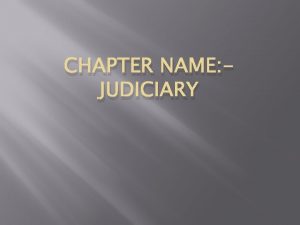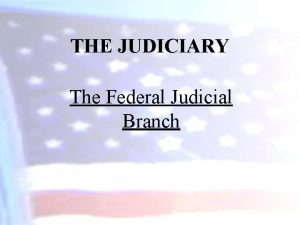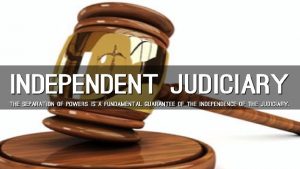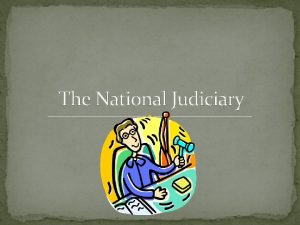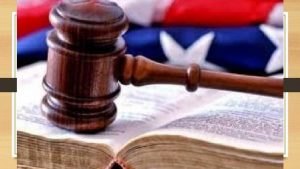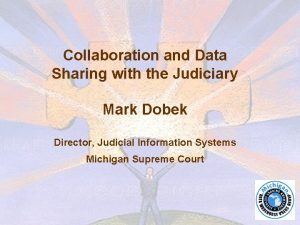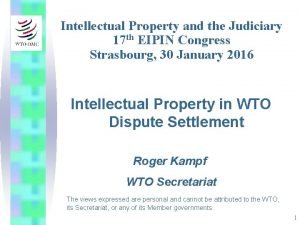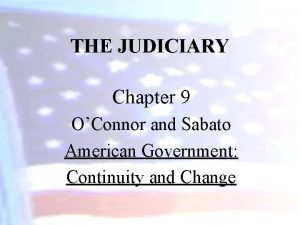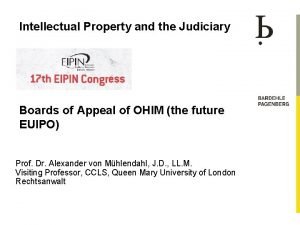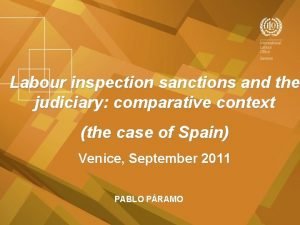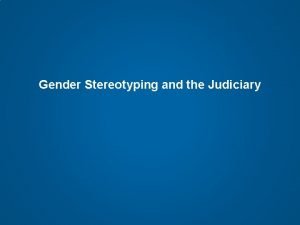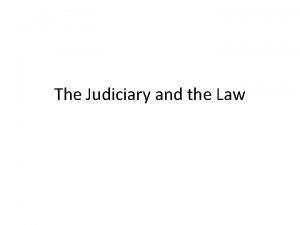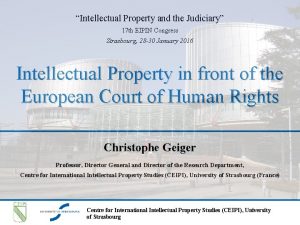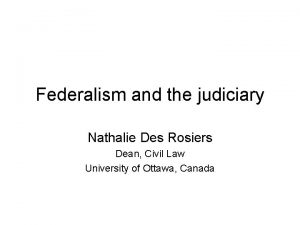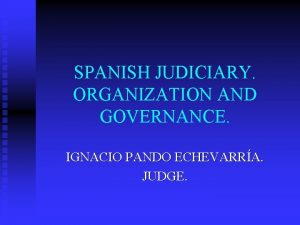14 The Judiciary 14 1 The Judiciary and










































- Slides: 42

14 The Judiciary 14 -1

The Judiciary and English Legal Tradition The job of the courts is to resolve legal disputes using the adversarial system. • The U. S. Legal System is based on the English Legal Tradition. • It includes the Adversarial system, trial by jury, and appeals. • Under an adversarial system, each party presents its version of events, with virtually all attempts to slant information—short of lying under oath—deemed acceptable. The Judiciary 14 -2

The Judiciary and English Legal Tradition (Cont’d) The right to trial by jury dates back in England to the Magna Carta (1215), where it replaced trial by ordeal, the practice of subjecting people to drowning or burning to see if they were innocent. • Trials involve questions of fact. • If trial courts make mistakes about questions of law, the American legal system allows for appeals. • Appeals are heard by appeals courts and by the Supreme Court. The Judiciary 14 -3

Civil versus Criminal Law Trials resolve two distinct types of disputes. • In criminal cases, the government prosecutes an individual for breaking the law. • In civil suits, a plaintiff sues a defendant to enforce a right or to win monetary damages. – The U. S. Constitution guarantees jury trials in all criminal cases and in all civil suits over $20. – Today, Congress limits access to the federal courts in monetary civil suits to claims of $75, 000 or more. – Suits for lesser amounts must go to state courts. The Judiciary 14 -4

Criminal and Common Law Criminal law is based on statutory authority. • When there are gaps in statutory law, the courts rely on judge-made law known as common law. – Common law requires that judges accept and rely on previous decisions or precedent. The Judiciary 14 -5

Constitutional Grants—Article III of the Constitution and the Judiciary Act of 1789 established the judicial branch of government. • Article III briefly refers to the Supreme Court of the United States and grants Congress the authority to create lower courts at its discretion. • The Judiciary Act of 1789 established the structure of the courts: – Today, there are 94 district courts, 13 circuit courts and 1 Supreme Court. The Judiciary 14 -6

Jurisdiction The lawful authority of a court to hear a case is its jurisdiction. • For the Supreme Court, there are two types of jurisdiction: – appellate, which is the authority to hear cases from lower courts (both state and federal), and – original, which is the authority to hear the case first. • The Supreme Court has original jurisdiction in cases involving foreign dignitaries and disputes between states. • The Constitution grants the federal courts the authority to hear cases of law and equity, constitutional interpretation, and statutory interpretation. The Judiciary 14 -7

Judicial Appointments The Constitution grants the president the authority to nominate judges, but these nominations are subject to the advice and consent of the Senate. • Judges confirmed by the Senate serve during “good behavior, ” or life, unless otherwise removed. – The Senate established a custom crucial to judicial independence: that judges would not be removed due to partisan disagreements with their decisions. The Judiciary 14 -8

Judicial Review Constitutional interpretation brings forth the greatest power of the federal judiciary, judicial review. • Judicial review is not found specifically in the Constitution. • The Supreme Court granted itself the power of judicial review in the case of Marbury v. Madison (1803). The Judiciary 14 -9

The Marshall Court (1801– 1835) The Court did not become a force to be reckoned with until John Marshall became the Chief Justice in 1801. • Marbury v. Madison (1803) formed the basis for judicial review. • Expanded federal government power: ― Mc. Culloch v. Maryland (1819): The court invoked the Necessary and Proper Clause. ― Gibbons v Ogden (1824): Court held that the power to regulate interstate commerce was granted to Commerce through the Commerce Clause. • Cohen v. Virginia (1821): Established the authority of federal courts over state courts, which upheld the Supremacy clause. The Judiciary 14 -10

Number of Nations Adopting Judicial Review, 1800– 2008 The Judiciary 14 -11

Limits on Power (1830 s– 1930 s) Beginning in the 1830 s, the Supreme Court began limiting national power over slavery and later, civil rights, and over governmental efforts to regulate the economy. • Dred Scot v Sanford (1857) ― No black person could be an American citizen; Congress did not have the authority to regulate slavery in the territories. ― The decision was overturned by the Fourteenth Amendment. • The Supreme Court prevented post-civil war attempts to regulate the economy by narrowly interpreting the Commerce Clause (Sugar Trust Case) and using the Due Process Clause to prevent state laws (Minimum Wage Laws and the right to contract). The Judiciary 14 -12

Strengthened National Power (1930 s to present) • Much of Franklin D. Roosevelt’s New Deal legislation—which aimed to alleviate the nation’s economic hardships—was struck down by the Court. • Under pressure from Congress and Roosevelt, the Court eventually opened a gateway by allowing the federal and state governments greater leeway in regulating the economy. The Judiciary 14 -13

Strengthened National Power (Cont’d) Increased Protections for Civil Liberties and Civil Rights • • The Court dealt increasingly with questions of civil rights and civil liberties, making them binding on the states (selective incorporation). The Warren Court (1953– 1969) greatly expanded the interpretation of liberties (which upset Conservatives). ― Expanded First Amendment liberties ― Expanded Civil Rights with Brown v Board of Education and reapportionment decisions ― Created a Right to Privacy ― Expanded the liberties of the criminally accused The Judiciary 14 -14

The Appointment Process District Courts • When a vacancy occurs in a district court, the president selects a nominee. ―Presidential staff consult with this state’s senators if they are members of the president’s party; because if one of them is opposed, he/she can invoke the norm of senatorial courtesy and receive the support of other members of the Senate in blocking that nominee. ―The Senate Judiciary Committee conducts hearings on the nominees. ―Confirmation of district court judges is generally routine, with nearly 90 percent of nominees approved since the Carter administration (1977– 1981. The Judiciary 14 -15

The Appointment Process (Cont’d) The Court of Appeals The formal process is the same as that of district court judges, but the Senate and outside interest groups pay closer attention to the nominees. ― Court of appeals judges represent multiple states; seats informally “belong to” particular states, so senatorial courtesy still applies. ― The Senate has failed to confirm more than 20 percent of court of appeals nominees since Jimmy Carter’s administration. ― In 2010, Senate Republicans began extensive use of holds, a process by which a single senator can block the unanimous consent agreements by which the Senate operates, to prevent votes on many of President Obama’s nominees. • The Judiciary 14 -16

The Appointment Process (Cont’d) The Supreme Court • The appointment of a Supreme Court justice is a highstakes affair. • Often, presidents choose nominees in part because of perceived electoral advantages. • Presidents also try to choose nominees who are close to them ideologically, hoping to shape the direction of the Court. • In recent times, nominees for the Supreme Court always receive hearings from the Senate Judiciary Committee. • There has been a substantial growth in interest group involvement in Supreme Court nominations. The Judiciary 14 -17

Number of Interest Groups Supporting and Opposing Supreme Court Nominees in Senate Judiciary Committee Hearings, 1970— 209 The Judiciary 14 -18

The Supreme Court Once on the floor, senators debate the pros and cons of the nominee until the vote is set. • The votes by senators largely depend on two crucial factors about the nominees: their perceived ideology and their perceived qualifications. – Senators are much more likely to vote for nominees who are ideologically close to them; votes are increasingly partisan. – Since the Bork rejection, nominees have dodged questions about their beliefs. The Judiciary 14 -19

Ideological Distance and Voting for Supreme Court Nominees The Judiciary 14 -20

Qualifications and Voting for Supreme Court Nominees The Judiciary 14 -21

State Courts Each state has its own judicial system, and unless a case involves federal law or the type of parties that create federal jurisdiction, cases get resolved in state courts. • Cases that begin in one of the fifty separate state court systems that nevertheless involve federal issues can be appealed to the federal court system in one of two ways. – Criminal defendants, who have gone through their last appeal at the state level, can file a writ of habeas corpus with a U. S. District Court. – Any parties who have exhausted their state appeals can file a request for review, known as a writ of certiorari, directly with the Supreme Court. The Judiciary 14 -22

Judicial Organization in the United States The Judiciary 14 -23

District Courts • • The Judiciary Act of 1789 established 13 district courts for the 13 states. Today, there are 94 districts. Many states have more than one district, but no district covers more than one state. Altogethere are 678 district judgeships. Trials at the district courts are either criminal or civil. The Judiciary 14 -24

Civil Procedure • • Most federal court cases settle out of court with a negotiated agreement between the plaintiff and the defendant. The process for a case that has a Judge is as follows: – Discovery grants each side access to information relevant to its suit held by the other side. – The attorneys for each side can also question witnesses for the other side in a process known as deposition. – Outside interests can file amicus curiae (friend of the court) briefs, stating their concerns in a case. The Judiciary 14 -25

Criminal Procedure • • • Criminal prosecutions begin with an alleged violation of federal criminal law. Under the Constitution, accused criminals in federal courts have a right to indictment by a grand jury. About 90 percent of federal criminal cases are resolved through a plea bargain. – The accused has the right to a trial by jury, but can request a bench trial. The Judiciary 14 -26

The Courts of Appeals Above the 94 district courts are the U. S. Courts of Appeals. They are divided geographically into 11 circuits plus a circuit for the District of Columbia and a “federal circuit” that hears appeals from courts that deal with patents and customs. • The number of judgeships in each circuit ranges from just six in the First Circuit, to twenty-nine in the Ninth Circuit. • Regardless of the number of judgeships, the courts usually hear appeals from the district courts in three-judge panels. • The courts have mandatory jurisdiction over cases that appeal to it. The Judiciary 14 -27

U. S. Courts of Appeals and U. S. District Courts The Judiciary 14 -28

The Supreme Court of the United States Each year, about 8, 000 losing litigants ask the Supreme Court to review their cases. • The Court’s decision to grant certiorari is purely discretionary. ― The Rule of Four: This is the practice by the Supreme Court to agree to hear a case if any four justices vote to grant certiorari. ― It only occurs 1% of the time; lower court decision stands in other 99% of cases. • The current Court hears about 100 cases a year. Although the Supreme Court is the highest court in the United States, it hears only a small percentage of cases filed in federal court. • Because of the number of cases appealed each year, law clerks tend to do most of the early review. The Judiciary 14 -29

The Supreme Court of the United States (Cont’d) In 1929 Chief Justice William Howard Taft— the only chief justice who was also a president —convinced Congress to move the Supreme Court out of the U. S. Capitol to “a building of dignity and importance suitable for its use as the permanent home of the Supreme Court of the United States. ” The new building, across the street from the Capitol, was completed in 1935. The Judiciary 14 -30

Oral Arguments Parties provide written briefs explaining their side and normally receive thirty minutes each for oral argument, although the justices frequently interrupt with questions. • Oral arguments for the U. S. Supreme Court have recently become available for the public on the Court’s Web site within days after case has been heard. – http: //www. supremecourt. gov/oral_arguments/oral _arguments. aspx The Judiciary 14 -31

The Decision Within a few days of oral argument, the justices meet in conference to vote on the merits of the case; that is, to decide which side wins, and to assign a justice to write the Opinion of the Court in the case. • If the chief justice is in the majority, he assigns who writes the opinion. • If the chief justice is not in the majority, the assignment is made by the senior justice who is in the majority. • The Opinion explains the Court’s justification for its decision and sets guidelines for other courts to follow in subsequent cases. The Judiciary 14 -32

Opinions • Majority opinion: Opinion of a court laying out the official position of the court in the case • Concurring opinion: Opinion by a judge that agrees with the court majority’s result (that is, which party wins) but sets out a separate rationale • Dissenting opinion: Opinion written by judges who disagree with the result reached by the majority as to who should win a case • Plurality judgment: Opinion of the court that results when a majority of the justices cannot agree on the rationale for a decision The Judiciary 14 -33

Ideology and Votes of Supreme Court Justices in the Gratz and Grutter cases The Judiciary 14 -34

Impact The fact that the Supreme Court issues a decision does not necessarily mean that governmental officials will comply (see Brown I and II). • If the decision is based on the meaning of a statute, it can be overturned by Congress, state legislatures, or through referenda. • When the Supreme Court declares something unconstitutional, legislatures find it difficult to overturn. • Most Supreme Court decisions, however, and virtually all of its constitutional decisions, are not overturned by Congress or via amendment. The Judiciary 14 -35

Constitutional Amendments Overturning Supreme Court Decisions The Judiciary 14 -36

The Judiciary and Public Policy The job of the courts is to interpret the law, but in doing so, they often appear to go beyond mere interpretation and instead get actively involved in policymaking. • According to the legal approach, justices base their decisions on legally relevant materials, such as prior court precedents, the plain meaning of the text of the law under consideration, and the intent of the Framers of the law. ― Legal approaches often fail to provide a good indicator of what the Supreme Court will do. The Judiciary 14 -37

The Extralegal Approach Extralegal factors are those that go beyond the legal factors that courts are supposed to consider. • The most important extralegal considerations include the justices’ own preferences and strategic considerations based on the preferences of others. – Justices take into consideration the preferences of their colleagues, as well as other members of government (the President). The Judiciary 14 -38

Ideology of Supreme Court Justices The Judiciary 14 -39

Justices’ Votes by Justices’ Ideology, 1953– 2009 Terms The Judiciary 14 -40

Activism and Restraint Given the undemocratic nature of judicial review, politicians frequently decry judicial activists, judges who go beyond what the law requires and seek to impose their own policy preferences on society through their judicial decisions. • These critics insist that judges should act with judicial restraint; that is, judges should respect the decisions of other branches, or, through the concept of precedent, the decisions of earlier judges. – Contemporary research suggests that justices respect the decisions of legislatures and earlier judges when those decisions are consistent with the justices’ ideology but are quite willing to overturn laws and precedents that are distant from their ideologically. The Judiciary 14 -41

Focus Questions • • • Why is the apparently simple requirement of providing “equal protection of the laws” in fact more difficult than it seems? In what ways do the federal courts lack traditional means of accountability? How are courts, nevertheless, responsive? Do citizens have equal access to the justice system? Does the justice system treat them equally? Is the judiciary a gate, or a gateway, to democracy? The Judiciary 14 -42
 Judicial activism vs restraint
Judicial activism vs restraint Uae national agenda
Uae national agenda Judiciary transformation framework
Judiciary transformation framework Department of judiciary
Department of judiciary Judiciary system in india
Judiciary system in india Vuk cucic
Vuk cucic Whats the judiciary act
Whats the judiciary act Hình ảnh bộ gõ cơ thể búng tay
Hình ảnh bộ gõ cơ thể búng tay Lp html
Lp html Bổ thể
Bổ thể Tỉ lệ cơ thể trẻ em
Tỉ lệ cơ thể trẻ em Gấu đi như thế nào
Gấu đi như thế nào Chụp tư thế worms-breton
Chụp tư thế worms-breton Hát lên người ơi
Hát lên người ơi Môn thể thao bắt đầu bằng chữ đua
Môn thể thao bắt đầu bằng chữ đua Thế nào là hệ số cao nhất
Thế nào là hệ số cao nhất Các châu lục và đại dương trên thế giới
Các châu lục và đại dương trên thế giới Cong thức tính động năng
Cong thức tính động năng Trời xanh đây là của chúng ta thể thơ
Trời xanh đây là của chúng ta thể thơ Mật thư tọa độ 5x5
Mật thư tọa độ 5x5 Phép trừ bù
Phép trừ bù độ dài liên kết
độ dài liên kết Các châu lục và đại dương trên thế giới
Các châu lục và đại dương trên thế giới Thể thơ truyền thống
Thể thơ truyền thống Quá trình desamine hóa có thể tạo ra
Quá trình desamine hóa có thể tạo ra Một số thể thơ truyền thống
Một số thể thơ truyền thống Cái miệng nó xinh thế chỉ nói điều hay thôi
Cái miệng nó xinh thế chỉ nói điều hay thôi Vẽ hình chiếu vuông góc của vật thể sau
Vẽ hình chiếu vuông góc của vật thể sau Nguyên nhân của sự mỏi cơ sinh 8
Nguyên nhân của sự mỏi cơ sinh 8 đặc điểm cơ thể của người tối cổ
đặc điểm cơ thể của người tối cổ Ví dụ giọng cùng tên
Ví dụ giọng cùng tên Vẽ hình chiếu đứng bằng cạnh của vật thể
Vẽ hình chiếu đứng bằng cạnh của vật thể Tia chieu sa te
Tia chieu sa te Thẻ vin
Thẻ vin đại từ thay thế
đại từ thay thế điện thế nghỉ
điện thế nghỉ Tư thế ngồi viết
Tư thế ngồi viết Diễn thế sinh thái là
Diễn thế sinh thái là Dot
Dot Số nguyên tố là
Số nguyên tố là Tư thế ngồi viết
Tư thế ngồi viết Lời thề hippocrates
Lời thề hippocrates Thiếu nhi thế giới liên hoan
Thiếu nhi thế giới liên hoan


